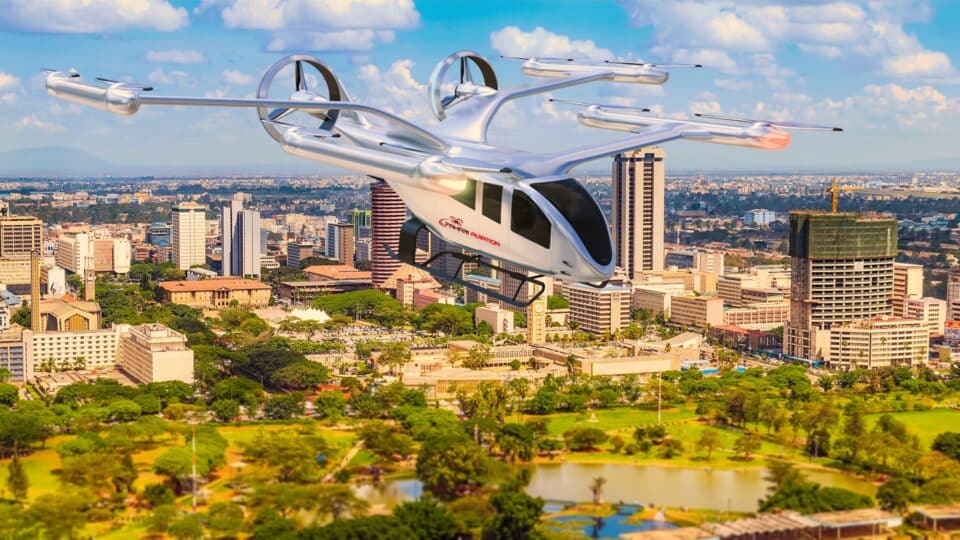Aerospace
Eve and Kenya Airways’ Fahari Aviation sign agreement to scale Urban Air Mobility with an order of up to 40 eVTOLs to fly people and cargo

The agreement involves joint studies to develop and scale the Urban Air Mobility (UAM) market in Kenya and a business model for cargo drone operations
Melbourne, FL, June 21, 2022 – In March 2022, a subsidiary of Eve Holding, Inc. (“Eve”) (NYSE: EVEX; EVEXW) and Kenya Airways’ subsidiary, Fahari Aviation, signed a Letter of Intent (LoI) for up to 40 electric vertical take-off and landing (eVTOL) vehicles. The agreement includes joint studies through a working group to develop and scale the UAM market and a business model for cargo drone operations in Kenya. The project is expected to start deliveries in 2026.
Eve’s eVTOL lift & cruise vehicle is electric-powered and the most practical design for efficiency and certifiability. Its multiple rotors are used to take off and land vertically, and at cruise altitude the rear propellers push the aircraft forward as in a wing-borne flight, providing a low-noise experience and making it easier to move within cities while avoiding traffic jams.
China’s TP500 freight drone makes its maiden flight.(Opens in a new browser tab)
“Urban air mobility is the future of transport and we are honoured to be the champions of this in the region. The journey to realise the dream of eVTOL vehicles in Kenya is on course, and the partnership with Eve is a key achievement for us as part of the strategy to adopt new technologies as a growth strategy for the sustainable development of Africa,” said Allan Kilavuka, Group Managing Director & Chief Executive Officer, Kenya Airways.
“This is a new chapter of the Eve and Fahari Aviation partnership to strengthen both companies’ commitment to establishing the foundations that will sustainably support the ecosystem for urban air mobility in Kenya. Last year, we announced a collaboration to develop operational models for Fahari Aviation’s key markets, and today’s announcement confirms that it is evolving successfully,” said Andre Stein, co-CEO of Eve.

Aerospace
Boeing Transfers Rocket Stage to NASA, Paving Way for Human Moon Mission

Boeing has achieved a significant milestone by providing NASA with the second core stage of the Space Launch System (SLS) rocket.
This crucial component, crafted at NASA’s Michoud Assembly Facility (MAF), is set to propel the Artemis II crew into lunar orbit, marking humanity’s return to deep space after a 50-year hiatus.
The monumental Boeing-built rocket stage, the largest element of the Artemis II mission, will embark on a journey aboard the Pegasus barge, traveling 900 miles to NASA’s Kennedy Space Center.
Comparison of two legendary aircraft B777x vs B747 aircraft:Click here
Upon arrival, it will be meticulously integrated with other essential Artemis II components, including the upper stage, solid rocket boosters, and NASA’s Orion spacecraft within the iconic Vehicle Assembly Building. This intricate integration process is a vital step toward the eagerly anticipated Artemis II launch, slated for 2025.
“Boeing-built products helped land humankind on the moon in 1969, and we’re proud to continue that legacy through the Artemis generation,” remarked Dave Dutcher, vice president and program manager for Boeing’s SLS program. “Together, with NASA and our industry partners and suppliers, we are building the world’s most capable rocket and paving the way to deep space through America’s rocket factory in New Orleans.”
NASA, Lockheed Martin Reveal X-59 Quiet Supersonic Aircraft:Click here
The delivery of Core Stage 2 marks a significant achievement in the evolution of the SLS rocket. Towering over 200 feet and powered by four RS-25 engines, this core stage, coupled with two solid-fueled booster rockets, will generate a staggering 8.8 million pounds of thrust. This immense power is crucial to launching Artemis II and future missions into the vast expanse of space.
The SLS rocket stands unparalleled in its capability to transport both crew and substantial cargo to the moon and beyond in a single launch. Its extraordinary capacity will facilitate the delivery of human-rated spacecraft, habitats, and scientific missions to destinations including the moon and Mars, ushering in a new era of space exploration.
-

 Travel1 week ago
Travel1 week agoAir India to Expand US Operations with Three New Routes After a Decade
-

 Travel2 weeks ago
Travel2 weeks agoWhy We Should Avoid These Stamps in a Passport
-

 Airlines1 month ago
Airlines1 month agoInvestigations Reveal Fake Chinese Titanium in Boeing and Airbus Jets
-

 Tech4 weeks ago
Tech4 weeks agoChina’s CATL Plans 1,800-Mile Electric Plane Launch by 2027
-

 Airport3 days ago
Airport3 days agoTop 10 Largest Airports in the World by Size
-

 Aerospace4 weeks ago
Aerospace4 weeks agoChina’s Fighter Jets Turn Wings into Autonomous Drones
-

 Airlines4 days ago
Airlines4 days agoAir India Rolls Out A350s for Delhi-New York JFK and Newark Routes
-

 Defence3 weeks ago
Defence3 weeks agoBoeing Enhances Chinook with New Engines and Block II Upgrades at $96 Million







